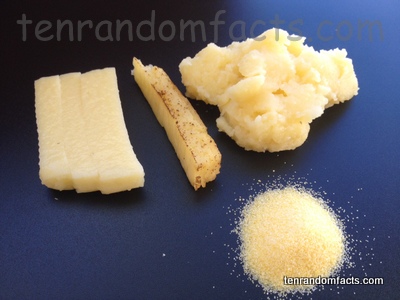Polenta was a peasant’s meal.
- Polenta is a porridge-like food made by boiling ground maize or other grain, and the dish is said to have originated Italy, where it was commonly eaten and eventually became a staple food among the poor and commoners in both Europe and North America.
- The term ‘polenta’ originates from the Latin word meaning ‘peeled barley’, and is linked to the Latin word ‘pollen’ meaning ‘fine flour’ or ‘mill dust’.
- Typically the grain used for making modern polenta is ground maize, known as ‘maize flour’ or ‘cornmeal’, and this ingredient is gluten free, making polenta a good alternative for those who can not have gluten.
- Before the availability of maize in Europe, polenta was eaten by Ancient Romans and was generally made of chickpeas, millet, spelt, chestnut flour, farro, or buckwheat, and today, the dish is sometimes made with a combination of these products.
- Polenta is most commonly yellow in colour, and can range anywhere between yellow and white, and the colour varies according to the grain used.
- Polenta is traditionally made by gradually adding cornmeal to a pot of boiling water, stock or other liquid, and simmering for up to 45 minutes, with occasional or continuous stirring over the period.
- The finer the grain used to make the polenta, the creamier the final product will be, and sometimes lengthier cooking times and more stirring can also improve the texture.
- Once boiled, polenta will set if allowed to cool, and is commonly placed in a pan and refrigerated, and later cut into various shaped pieces for frying, grilling or baking, and eaten in various meals, and can be used as an alternative to bread or as a side.
- Polenta is high in vitamins C and A, and the food also contains protein, carbohydrates and fibre.
- Quick cooking polenta is available and is useful for cutting down the boiling time, and pre-made polenta can also be found packaged in supermarkets, and is ready to cut and bake or fry.
Bibliography:
A Brief History of Polenta, 2012, Food in Italy, http://www.foodinitaly.org/blog/2011/04/23/a-brief-history-of-polenta/
Demetri J, Polenta, 2012, Life in Italy, http://www.lifeinitaly.com/food/polenta.asp
Polenta, 2015, Wikipedia, http://en.wikipedia.org/wiki/Polenta







